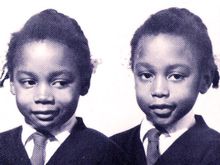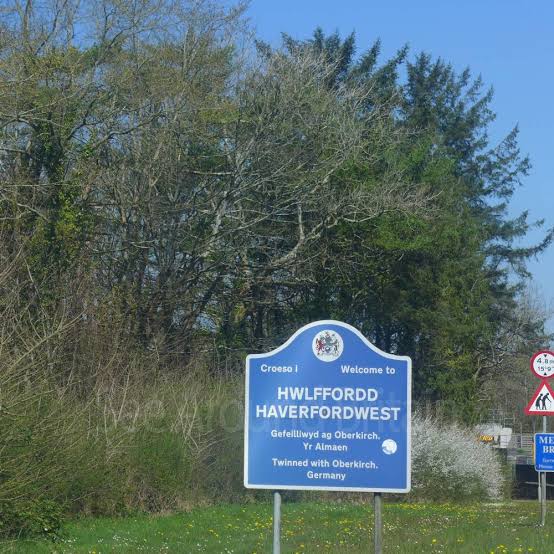
In 1963, twin girls were born in Yemen to Caribbean parents. Their names were June and Jennifer Gibbons. No one knew it then, but these sisters would one day become one of the most chilling and puzzling psychological mysteries of the 20th century.
Their father was a technician in the Royal Air Force. When the family moved to Haverfordwest, Wales, the girls were barely old enough to walk. But early on, their silence began. They didn’t speak much—if at all—to anyone around them.
At first, it was thought they were just shy. But it wasn’t just people outside the family they avoided. They didn’t talk to their parents, teachers, or their older siblings. Only to each other—and even that was in a private, fast-paced language no one else understood.

Their speech was eventually identified as a sped-up Bajan Creole, molded by their Barbadian roots and sharpened into something exclusive. Even tape recordings couldn’t make much sense of it. It was theirs and theirs alone.
Observers noticed something else too: they moved in eerie unison. If one reached for a cup, the other mirrored it. If one paused, so did the other. Their world was made for two, and everyone else was locked out.
Attempts to split them up were frequent—and fruitless. When placed in separate boarding schools, both girls shut down completely. June stopped eating. Jennifer sat motionless for days. Reunited, they would act like nothing had happened.
Their parents, baffled and desperate, turned to doctors. The doctors turned to psychologists. But no one could reach them. And the twins weren’t interested in being reached.
In private, though, they were extremely active. They wrote stories—wild, violent novellas filled with obsession, betrayal, and death. They filled diaries with thoughts about boys, fame, and, eventually, about each other in dark, almost resentful tones.
Jennifer once wrote that June was “a face in the mirror,” but “one that makes me feel pain.” June admitted that Jennifer had control over her, that “she is a dark shadow robbing me of sunlight.”
This wasn’t just teenage angst. Their bond had twisted into something heavier. A compulsion. A trap. The more they loved each other, the more they resented being fused so tightly together.
By their late teens, the twins had grown restless. They committed petty crimes. Then larger ones. They vandalized buildings and even set fire to a tractor store. For this, they were arrested and later sentenced to Broadmoor Hospital.
That’s when everything changed.
Broadmoor was a maximum-security psychiatric institution. It housed murderers and the criminally insane. Yet that’s where June and Jennifer were sent—for 11 years. They were 19 when they entered.

Inside, the twins were placed in separate rooms. They were heavily medicated and kept under strict observation. Still, they found ways to communicate—through writing, through coded movements. Their silence continued. Their pact held.
They never once denied what they had done. But it was clear to some of the staff that they weren’t a danger to others. Only to each other.
Journalist Marjorie Wallace began visiting the twins in Broadmoor. Over time, they opened up—to her, if not to the world. She was the only person they seemed to trust.

Wallace learned about their inner world—the stories, the fantasies, the rivalry. But more disturbingly, she began to notice that Jennifer seemed… resigned. She told Wallace she believed she was going to die.
It wasn’t a threat or a cry for help. Jennifer said it calmly. Repeatedly. “I’m going to die soon,” she told Wallace. “We’ve decided.”
Wallace didn’t know what to make of it. No medical condition suggested anything was wrong. Jennifer seemed healthy. But still, she insisted. The pact was in motion.
In March 1993, the twins were finally approved for transfer to a lower-security hospital. It was supposed to be a fresh start. A new chapter.
Instead, it became a funeral.
Jennifer Gibbons died en route to the hospital. No foul play. No overdose. Just an undiagnosed inflammation of the heart. It was so sudden that paramedics couldn’t revive her. She was 29.
June, for the first time in her life, began to speak.
She spoke clearly, openly, and to everyone. Doctors, nurses, journalists. She gave interviews. She lived independently. It was as if something had lifted.
And when Wallace asked her why she had started talking, June didn’t hesitate.
“One of us had to die,” she said, “so the other could live.”
Jennifer’s death was ruled natural—acute myocarditis, an inflamed heart muscle. But doctors couldn’t explain why it happened. No poison. No trauma. No prior symptoms. Just a healthy young woman who lay down and stopped breathing.
The medical mystery deepened when her heart was dissected. There were no viral infections, no structural defects, no drug interactions. Her body had simply… quit.
And still, the real story wasn’t in the autopsy. It was in June’s voice—clear, steady, and shockingly unburdened.
For a woman who barely spoke for three decades, June Gibbons suddenly had plenty to say. She laughed. She cried. She gave press interviews. “I’m free at last,” she told Marjorie Wallace. “Jennifer gave up her life for me.”
It wasn’t metaphor. June meant it literally. The sisters had made a decision, forged quietly between them, that one of them had to go. Jennifer had agreed to be the one.
They’d been discussing it for weeks. In diary entries recovered later, both hinted at an unspoken agreement. June wrote that she felt “trapped in a cage” by her sister. Jennifer admitted she was scared of June’s growing desire for independence.
But Jennifer also seemed resigned. “We have decided,” she wrote. “It must be done. There is no other way.”
Their bond, which looked like devotion from the outside, had become suffocating. A psychic tug-of-war where freedom meant loss, and speech meant death. Somehow, Jennifer believed she had to die so that June could live.
And she did.
The world didn’t know what to do with this story. Some called it a case of folie à deux—a shared psychosis. Others labeled it psychological martyrdom. But nothing quite fit.
Their time at Broadmoor didn’t help. Locking up two mentally sound girls for 11 years in a hospital built for the violently insane raised questions—especially because they were Black, poor, and female in Thatcher’s Britain.
Would two middle-class white twins have faced the same fate? Would they have been institutionalized for teenage arson and shoplifting? Or treated and released?
June herself hinted at this. In a later interview, she said: “We were young then. We didn’t deserve Broadmoor. We needed help, not prison.”
Some saw their silence as a disorder. Others saw it as a protest.
When Marjorie Wallace released her book The Silent Twins, readers were shocked not just by the twins’ behavior—but by the raw intelligence and creative hunger that filled their diaries and novels. These girls were never dull or blank. They were bursting with thought.
Their stories, though amateurish, revealed a fascination with identity, control, and twins separated by fate. Characters were often locked in obsessive friendships. One always ended up dead. Sometimes by accident. Sometimes not.
It wasn’t just writing. It was foreshadowing.
After Jennifer’s death, June gradually built a life. She moved near her family in West Wales. She worked quietly, took art classes, and even spoke at schools about mental health. But she never fully escaped the ghost of her sister.
In interviews, she’s open but hesitant. She says she feels guilt. That Jennifer should still be here. That she thinks about her daily. But also, that she’s alive because Jennifer died. That she’s grateful.
It’s the kind of paradox only June can live with.
To this day, no one truly knows what happened between the Gibbons sisters. Was Jennifer’s death a psychosomatic event—a mind willing the body to stop? Or a form of twin suicide cloaked in consent?
Some believe it was spiritual. Others think it was planned, albeit unconsciously. There was no poison, no note, no evidence of self-harm. Just a heart that stopped on the day it was meant to.
And still, the most haunting detail is the simplicity with which June explains it.
“We made a pact. And my sister is dead now. So I am free.”
Sources:
- Wallace, M. The Silent Twins, Vintage Books, 1997
- Interviews with June Gibbons (BBC, 2000; Guardian, 2008)
- Hospital reports, Broadmoor archives
- Smithsonian Magazine feature, “The Mysterious Bond of the Silent Twins”






To answer your cheap question about non minority children being sentenced to broadmore yes they have. For centuries. And they have been overwhelmingly male. Do better research or stop writing and go into something that better suites your intelligence. Like retail or government